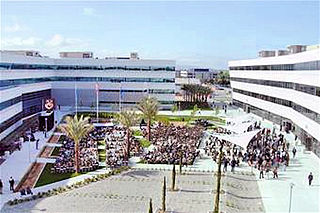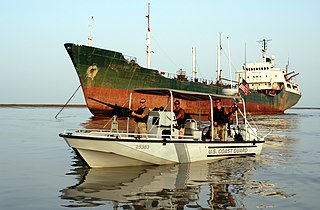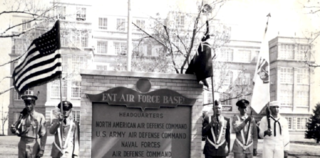
The United States Air Force (USAF) is the air service branch of the United States Armed Forces, and is one of the eight U.S. uniformed services. Initially formed as a part of the United States Army on 1 August 1907, the USAF was established as a separate branch of the U.S. Armed Forces on 18 September 1947 with the passing of the National Security Act of 1947. It is the second youngest branch of the U.S. Armed Forces and the fourth in order of precedence. The U.S. Air Force articulates its core missions as air supremacy, global integrated intelligence, surveillance and reconnaissance, rapid global mobility, global strike, and command and control.

North American Aerospace Defense Command, known until March 1981 as the North American Air Defense Command, is a combined organization of the United States and Canada that provides aerospace warning, air sovereignty, and protection for Northern America. Headquarters for NORAD and the NORAD/United States Northern Command (USNORTHCOM) center are located at Peterson Space Force Base in El Paso County, near Colorado Springs, Colorado. The nearby Cheyenne Mountain Complex has the Alternate Command Center. The NORAD commander and deputy commander (CINCNORAD) are, respectively, a United States four-star general or equivalent and a Canadian three-star general or equivalent.

The Joint Chiefs of Staff (JCS) is the body of the most senior uniformed leaders within the United States Department of Defense, that advises the president of the United States, the secretary of defense, the Homeland Security Council and the National Security Council on military matters. The composition of the Joint Chiefs of Staff is defined by statute and consists of a chairman (CJCS), a vice chairman (VJCS), the service chiefs of the Army, Marine Corps, Navy, Air Force, Space Force, and the chief of the National Guard Bureau. Each of the individual service chiefs, outside their JCS obligations, work directly under the secretaries of their respective military departments, e.g. the secretary of the Army, the secretary of the Navy, and the secretary of the Air Force.

The Cheyenne Mountain Complex is a Space Force installation and defensive bunker located in unincorporated El Paso County, Colorado, next to the city of Colorado Springs, at the Cheyenne Mountain Space Force Station, which hosts the activities of several tenant units. Also located in Colorado Springs is Peterson Space Force Base, where the North American Aerospace Defense Command (NORAD) and United States Northern Command (USNORTHCOM) headquarters are now located.

United States Strategic Command (USSTRATCOM) is one of the eleven unified combatant commands in the United States Department of Defense. Headquartered at Offutt Air Force Base, Nebraska, USSTRATCOM is responsible for strategic deterrence, global strike, and operating the Defense Department's Global Information Grid. It also provides a host of capabilities to support the other combatant commands, including integrated missile defense; and global command, control, communications, computers, intelligence, surveillance, and reconnaissance (C4ISR). This command exists to give national leadership a unified resource for greater understanding of specific threats around the world and the means to respond to those threats rapidly.

The United States Transportation Command (USTRANSCOM) is one of eleven unified combatant commands of the United States Department of Defense. The command is located at Scott Air Force Base, Illinois, and was established in 1987.

The United States Southern Command (USSOUTHCOM), located in Doral, Florida in Greater Miami, is one of the eleven unified combatant commands in the United States Department of Defense. It is responsible for providing contingency planning, operations, and security cooperation for Central and South America, the Caribbean, their territorial waters, and for the force protection of U.S. military resources at these locations. USSOUTHCOM is also responsible for ensuring the defense of the Panama Canal and the canal area.
Network-centric warfare, also called network-centric operations or net-centric warfare, is a military doctrine or theory of war that seeks to translate an information advantage, enabled in part by information technology, into a competitive advantage through the robust computer networking of well informed geographically dispersed forces. It was pioneered by the United States Department of Defense in the 1990s.

Los Angeles Air Force Base (LAAFB) is a United States Space Force Base located in El Segundo, California. Los Angeles Air Force Base houses and supports the headquarters of the United States Space Force's Space Systems Command (SSC), which was activated on Aug. 13, 2021. The center manages research, development and acquisition of military space systems. The 61st Air Base Group provides support functions for the base.
The Joint Functional Component Command for Intelligence, Surveillance and Reconnaissance was a subordinate command of the United States Strategic Command, one of the nine Unified Combatant Commands under the United States Department of Defense (DOD) and co-located with the Defense Intelligence Agency (DIA). It served as the center for planning, execution and assessment of the United States military's global Intelligence, Surveillance, and Reconnaissance operations from 2005-2016; a key enabler to achieving global situational awareness. In 2016 JFCC-ISR was realigned to the Joint Staff.

The United States under secretary of defense for policy (USDP) is a high level civilian official in the United States Department of Defense. The under secretary of defense for policy is the principal staff assistant and adviser to both the secretary of defense and the deputy secretary of defense for all matters concerning the formation of national security and defense policy.

United States Coast Guard Port Security Units are deployable specialized units organized for sustained force protection operations. They can deploy within 96 hours and establish operations within 24 hours of arrival. PSUs conduct OCONUS port security in support of requesting regional Combatant commander. They provide Anti-Terrorism and Force Protection missions which include harbor and port defense, Humanitarian aid, coastal surveillance, and special missions. PSUs usually operate in U.S. territorial waters under the direction of the Coast Guard’s command, but can quickly be called upon the Department of Defense request.

Camp Taji, also known as Camp Cooke, is a military installation used by Iraqi and coalition forces near Taji, Baghdad Governorate, Iraq. The camp is located in a rural region approximately 27 km (17 mi) north of the capital Baghdad in the Baghdad Governorate.

Garland Porter “Gar” Wright Jr. is a retired Rear Admiral of the United States Navy. His final active duty assignment was as deputy director of the Defense Threat Reduction Agency. He previously served as Commander Joint Task Force 134, and prior to that as Deputy Chief of the Navy Reserve. He is a 1977 graduate of the United States Naval Academy where he was co-captain of Navy's first National Championship Sailing team and named an intercollegiate "All American."
Joint Interagency Task Force South is a United States multiservice, multiagency task force based at Naval Air Station Key West, Key West, Florida.

Continental Air Defense Command (CONAD) was a Unified Combatant Command of the United States Department of Defense, tasked with air defense for the Continental United States. It comprised Army, Air Force, and Navy components. It included Army Project Nike missiles anti-aircraft defenses and USAF interceptors. The primary purpose of continental air defense during the CONAD period was to provide sufficient attack warning of a Soviet bomber air raid to ensure Strategic Air Command could launch a counterattack without being destroyed. CONAD controlled nuclear air defense weapons such as the 10 kiloton W-40 nuclear warhead on the CIM-10B BOMARC. The command was disestablished in 1975, and Aerospace Defense Command became the major U.S. component of North American Air Defense Command (NORAD).

The People's Liberation Army Strategic Support Force is the space, cyber, and electronic warfare force and the 5th branch of China's People's Liberation Army (PLA). It was established in December 2015 as part of the first wave of the Chinese military reforms.
The Marine Air Command and Control System (MACCS) is the aviation command and control agencies of the United States Marine Corps that provide the Aviation Combat Element (ACE) commander with the means to monitor, supervise, and influence aviation operations in support of the Marine Air-Ground Task Force. The command and control agencies of the MACCS are provided by the squadrons and battalions of the Marine Air Control Groups that are present within each Marine Air Wing. The capabilities resident within the MACCS allow the MAGTF commander to safely conduct aviation operations, facilitate timely maneuver and prosecution of fires and ultimately retain full control of their entire area of operations. MACCS agencies are also responsible for coordinating Marine Corps aviation operations with joint, multinational and civil aviation.

The Aerospace Operations Command is a Brazilian air and space command created in 2017 and is part of the Brazilian Air Force. Is responsible for planning, coordinating, executing and controlling the country's air and space operations. The Brazilian Navy and Brazilian Army also are part of the organization.














